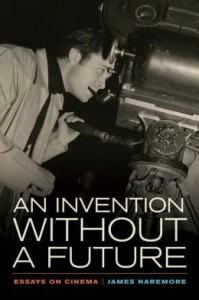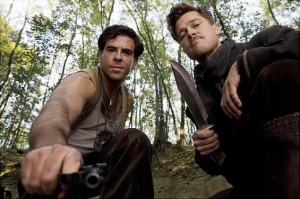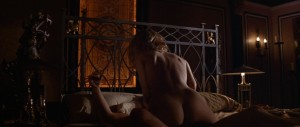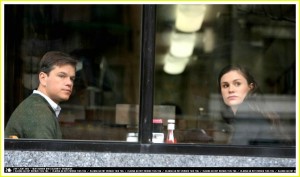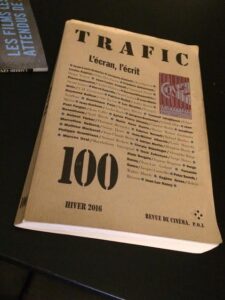I’m thrilled that my favorite academic film critic, James Naremore, finally brought out a collection of his critical and theoretical essays, and even more thrilled that its final section, “In Defense of Criticism,” includes an essay on me (along with essays on James Agee, Manny Farber, and Andrew Sarris, and extracts from Jim’s own ten-best columns for Film Quarterly between 2007 and 2010). Naremore’s essay about me ends with an email interview, and Jim has given me permission to reprint that text here. You can order his book, An Invention without a Future: Essays on Cinema — which also contains some wonderful material about Hawks, Hitchcock, Huston, Kubrick, Minnelli, and Welles, as well as about such topics as acting, auteurism, and literary adaptation — on Amazon. — J.R.
I took advantage of my friendship with Jonathan Rosenbaum to interview him on e-mail about the practical concerns or realpolitik of working as a film reviewer. His replies give us insight into at least one corner of the world of critical journalism:
JN: As a weekly film reviewer for the Chicago Reader, were you given the word length you needed for reviews? Was there any pressure, however subtle, to review big commercial films over art films and revivals? Any censorship of politics or judgment? Would the situation be different for reviewers at the Tribune, The New Yorker, or The New York Times?
JR: For most of my 20 years at the Reader, I had virtually unlimited space. Eventually, I had to limit the length of my capsule reviews and also (a practice that continues to this day) condense earlier ones that were being reprinted; and after roughly 17 years, my long reviews had to become much shorter. During much of this time, my editors would sometimes complain about my not reviewing the big commercial films more frequently, but I can’t recall them ever putting their foot down about this. Even better, for most of this period, they allowed me to write at length about some commercial releases weeks or even months after they opened, as long as they were still playing somewhere in Chicago. This freedom was eventually withdrawn so that my reviews had to come out the same week as the films. As far as I know, none of these of these freedoms, when they existed, ever existed at the Tribune, The New Yorker, or the Times — although I hasten to add I’ve only written once for any of these publications, when I was commissioned to write an op-ed piece for the Times after Ingmar Bergman died. This had to be rewritten several times, and in retrospect my agreeing to accept their invitation was tantamount to signing a pact with the devil — giving up much of my freedom and autonomy in exchange for mainstream exposure.
I was always edited at the Reader, usually by excellent editors, and the main freedom I lacked was the ability to choose the titles of my longer pieces — a freedom I’ve rarely had elsewhere with any consistency. There was never any interference about my judgments, and instances of political censorship were infrequent. I can recall only two, both of them sore points. Significantly, neither came from my most frequent copy-editor at the time — who was far more conservative than me (even though the Reader was basically a leftist paper, especially on local issues), leading to many heated quarrels — but from the main editor, who didn’t believe she was censoring me and thought she was simply holding me to certain journalistic standards. In one case, she objected to me citing the claim that Bush and Cheney had hopes of finding a way to invade Iraq before 9-11, which she considered a paranoid fantasy; in the other case, she objected to me claiming, after a visit to Tehran, that Iran was as ethnically and racially multicultural as the U.S., without offering anything she regarded as evidence. (It was only much later, alas, that I discovered that figures on the CIA’s web site would have furnished this evidence.) In both cases, I felt these deletions were censorship because of how selective she was being about what claims of mine required evidence — and because she wasn’t even allowing me to cite an opinion that others could claim was wrong.
It’s important to add that during this same 20-year period, what were formerly called “alternative” newspapers stopped being alternative, especially in their outlook. Not long after the Reader went online, it started listings of “what the Reader is reading,” and these tended to be exclusively items in the mainstream press. More generally, “alternate” newspapers showed an increasing desire to duplicate mainstream publications, which struck me as suicidal — one reason why I decided to go freelance after 20 years, a decision I haven’t regretted. If any “alternative” journalism survives today, it’s clearly on the Internet, but by and large, I believe the whole concept of “alternative” outlets has been replaced by the concept of niche markets, which I tend to find more congenial. Another way of putting this is to say that I enjoy being a cult writer, which can bring more intensity to one’s engagement with readers. The few times I’ve written for big mainstream publications with millions of readers, the responses have been far less satisfying even when they’re intense—in part because it’s hard to sort out how much they’re responding to the institutional aura of those publications.
JN: How large was your readership, and how did you imagine your typical reader? How did you conceive the public role of a film critic? Did you get much positive or negative mail from readers?
JR: To cite some figures from pp. 262-263 of my collection Placing Movies (California, 1995): “On the basis of a detailed survey about its readership carried out a few years ago, the Reader…has a circulation of 137,000 and an estimated readership of about 412,000….[T]he movie listings and capsule reviews [were] the most widely read or ‘looked at’ featured in the paper,” while the long reviews came in third, “with front-cover articles in second place and cartoons in fourth.” Most of the paper’s highly targeted readership was single (77%) and white (77%), with a median age of 31 and a median annual household income of $39,500, which was quite close to my salary at the time. By contrast, over the past month (writing on January 8, 2013), over 67,000 visits have been paid to my web site by 52,000 people. But whereas my readers at the Reader were almost exclusively Chicagoans, those at my web site live in 165 separate countries, with over 26,000 of these based in the U.S. (2,258 of them are in New York, the highest concentration in a single city, and roughly half that number are in Chicago), approximately a tenth as many in France, and 249 each in Croatia and Egypt, to cite a few more random figures.
For me, the film critic’s principal role is to assist in the public discussion of films — a discussion that usually starts before the critic arrives and continues long after the review is read. Godard once said to me in an interview that he wanted to be regarded as an airplane rather than an airport, and this is an aspiration I share — meaning, to some extent, that people should take me to get wherever they want to go and then step off. At the Reader, I would say that the mail I received was both relatively sparse and more positive than negative, except for when I wrote an attack on something like Star Wars or No Country for Old Men, when it became voluminous and mainly negative. Today, based on what I access via emails, Twitter, Facebook, and blogs, most of the feedback I get is highly supportive and positive — except for when I sound off against something like Inglorious Basterds, when it’s mainly dismissive and negative.
JN: How much time usually went by between seeing a film and turning in a review? Did you ever feel that the pressure of deadlines was causing you to make snap judgments or give insufficient attention to films? Did you ever want to take back what you wrote?
JR: My lead times usually varied a lot, because sometimes films get press-shown well in advance of their openings. Most often, when I wanted to see a film more than once before writing my review, I was able to, but I’m sure there were occasions when more time and/or further research would have altered my positions or sharpened my insights. When Basic Instinct came out in 1992, my long review was sarcastic and gave it no stars, but at some point afterwards I became a big Verhoeven fan and now regard it as one of his best movies. More recently, in my post-Reader phase, I called Margaret a “brilliant mess,” until another viewing persuaded me that it wasn’t a mess at all. One thing I like about my web site, over which I have complete editorial control, is the possibility of critiquing some of my earlier pieces, explaining how or why my mind got changed, and in a few cases, when I’m not happy with the way I was originally edited, making corresponding adjustments. In one of my more recent books, Discovering Orson Welles, I go out of my way to retain original errors of fact or judgment and then signal these flaws, for pedagogical purposes, to help demonstrate how shaky some Welles scholarship often turns out to be. The only long pieces of mine that I regret enough to exclude from my web site (in contrast to several others that I now simply disagree with or dislike for other reasons, and include) are an over-the-top attack on Donald Richie’s book on Ozu that I published in Sight and Sound and my dissenting piece about Bergman in the Times (which also drew a lot of negative mail), although in the second case I did post my original draft.
JN: In Goodbye Cinema, Hello Cinephilia, you’ve said that the digital revolution has led to “paradigmatic changes,” not only in the way we view movies, but also in the way we “think and write about them” (xv). Is good film criticism on the web different from good criticism in print? Are we experiencing a decline of good print criticism, and if so does that matter?
JR: This is a tougher question to answer than the others. As for changes in how we view movies, there are so many variations nowadays in the qualities of film prints and digital copies and the ways they get shown and seen that it’s hard to make any qualitative generalizations, just as one can’t really deal adequately with globalization simply by calling it “good” or “bad”. There are certainly important differences, but these vary a great deal in separate situations.
By and large, I think there’s more good stuff than ever and more bad stuff than ever on the Internet and one of the most striking paradigmatic changes from the past and print culture is how quickly one can get feedback to whatever one writes online. After seeing a Bresson film in the early 60s, you might have to wait a few weeks or months before reading about it in a film magazine, and sometimes wait as long or even longer before finding someone with whom you could discuss it. After seeing a Pedro Costa film today, you don’t have to wait for a social or communal response to either the film or your own written response to it if you post something about it—with the advantage of immediate feedback and the possibilities of international exchanges and the disadvantage of less time for reflection. (On Facebook and diverse blogs, it’s often disturbing to see how many people can post before thinking, and I’m sometimes guilty of this myself.)
We’re obviously experiencing a decline in reviews that appear on paper, but I disagree with those who think there’s much of a decline in what’s known as “professional” reviewing, because, as you know, I’m highly dubious about most of the criteria used in both academia and journalism for defining professionalism. And in book publishing, could one really argue that the BFI Film Classics, which we’ve both contributed volumes to, are any sort of downgrade from the monographs about directors that proliferated in France several decades ago? One could also maintain that even though Sight and Sound has been diminished nowadays by its more formulaic consumerist orientation, Film Quarterly and Cineaste have gotten livelier, and online journals such as Rouge and its semi-successor, Lola, are in many ways superior to almost all of the film magazines in English that appeared on paper in the so-called Golden Age of Criticism (i.e., the 60s and 70s). At the same time, even if one justifiably laments, in French criticism on paper, the depletion of energy and innovation in Cahiers du Cinéma, the 13 issues of Cinéma edited by Bernard Eisenschitz in 2002-2007, most of which included DVDs of rare and precious archival material, and the 84 issues of Trafic that have appeared since Serge Daney founded it in 1991, are hardly signs of decline.

